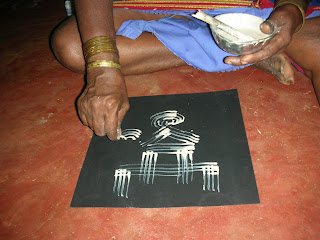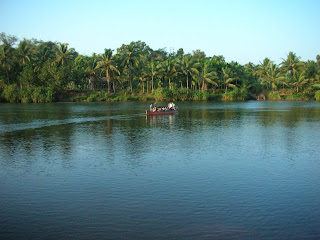
That was the time there was only water and rest of the earth had only forest.
The ancient man who has lived on nothing but what the land provides. Uncultivated or volunteer greens are nothing new in our culture. It's always there. The whole notion of 'weed' doesn't really exist. Earth was providing plenty of it in the form of medicinal herbs, greens, shoots, fruits, berries, roots mushrooms. Man developed the knowledge and skill to make do with what the earth has been given.
Knowledge of non-domesticated food resources is part of traditional and tacit ecological knowledge, and is largely transmitted through socialization within cultural and household contexts.
I was surprised when I met series of friends who had never actually eaten uncultivated or volunteer greens.
So this is a small initiative to upgrading the way we relate to our planet.
Who are the resource people?
When I realised there are plenty of greens which we can eat. The next question was
Whom do I ask? Is there a book/guide to recognize these plants? How to learn about these plants?
The local villagers who have lived on nothing but what the land provides, and they are still here. They have developed the knowledge and skill to make do with what they have been given. I realized there is a block to find potential sources of knowledge and i should examine it.
We have virtually disconnected ourselves from the land around us and all of the valuable gifts it contains
Unfortunately the knowledge hasn’t been passed on to the next generation and soon this knowledge will be nowhere.
The need:
The knowledge on wild plant foods is in danger of getting lost as habits, value systems and the natural environment change. To preserve this knowledge, which potentially is highly valuable for future generations, it needs to be documented systematically and made to be part of our diet.
Changing human lifestyle and taste, negligence of potential sources of knowledge, availability of foods in the market and development of transport systems are factors which lead people, specially the younger generation, to use more ready made fast foods.
Thus, the use of uncultivated foods is likely to decrease in the future, and important factors contributing to livelihood, culture and tradition are threatened to be lost
The Fact:
• The diversity of uncultivated plant species, their occurrence and relationship with cultivated species, and their use by humans have rarely been studied systematically
• The value and potential of uncultivated foods in the food security and nutrition of rural people is also neglected in agricultural and environmental programs
The value
• Millions of years of evolution have endowed these wild plants with the high concentrations of the vitamins, minerals, and fiber that they (and we) need to survive, plus way more flavor than their water-bloated commercial counterparts, which we usually breed for size alone.
• Wild foods are safer and more natural than supermarket food. Our ancestors survived by foraging for tens of thousands of years, whereas junk food has been killing us for less than a century, and genetically altered food is an even newer experiment.
• It’s fun and easy to learn to recognize and use wild plants. And it’s exciting and empowering to add wild plants to your meals while saving money, getting better acquainted with your bio me, and improving your health.
• It adds diversity and excitement to our diet
Conclusions
Uncultivated plant species used for consumption at times of food shortage, have the potential to become valuable staple foods and important alternatives to the usual food crops cultivated by farmers.
The option to improve food production through exploiting the potential of uncultivated food plants might be a sustainable, cheap and local alternative for decreasing the food shortage problem. At the same time, development of use of uncultivated food plants might contribute to biodiversity.. Without the understanding of the complimentary between staple crop foods and uncultivated food intake, agricultural planning will continue to be dominated by few major crops to the exclusion of such diverse and important resources. However, additional investigations on the use and availability of uncultivated plants in different regions are needed.
The initiative:
You will meet women like Puttamma around you who have lived on nothing but what the land provides. They have developed the knowledge and skill to make do with what they have been given.
My dream is to document 100 kinds of edible greens.(Puttamma says there are noorodu jaati soppu )I am optimistic about it. In one place (that too in Bangalore)( near Kaggalipura (Kanakpura road,Bangalore) where puttaamma (a soppu seller) usually collects her greens).
Puttamma learnt about soppu from Munitayamma 30 years back. She is in this job since then .Puttamma is 60 years old now. Her daughter is working in a Garment factory and son is a driver. Sadly next generation knows nothing about this knowledge.
GoLi soppu:
Thick leaves ,,small yellow flowers ..mild sour taste.. grows well near water bodies..spreads close to the ground.Puttamma says there are two kinds of goni /goLi soppu small and big.It can be seen malnaad region and wet lands in all the seasons. I saw them growing in my lay out and in the corners of footpaths in busy streets like koramangala in Bangalore.
You can gow them in your kitchen garden through cuttings .
Goli soppina saaru
- ingredients:1bunch of goli soppu,1/2 cup grated coconut,6 red chillies,1/2 tea spoon coriander seeds, 1/4 tea spoon cumin seeds, 1no. clove, 4 garlic,1/4 cup tur dal, tamarind,salt
- method:cook the greens with dal.stair fry all the ingredients grind with coconut, mix the masala with cooked daal and soppu. add salt tamarind juice and jaggary(optional) season with garlic.
Goli soppina sharakali:
- Ingredients:1bunch of goli soppu,5-6 green chillies, 6 cloves garlic, 2-3 i lemon salt
- Method: boil the soppu with green chillies and salt. grind into smooth paste. seson with garlic and jeera. goes well with hot rice or chapathi
Goli soppina raita/mosaru bajji
Ingredients:1bunch of goli soppu,1/4 cup grated coconut,1/4 cup curd
For seasoning:2-3 red chillies, 1/4 tea spoon udad dal, mustard seed,
Method: Chop the greens, boil with salt and little water.. grind the coconut into smooth paste.Mix with greens.Add curd. seson with red chillies, udad dal, mustard seed
,















































